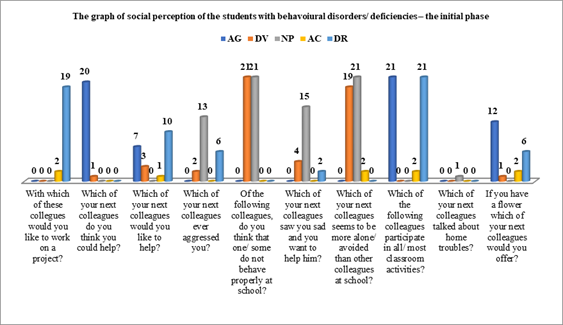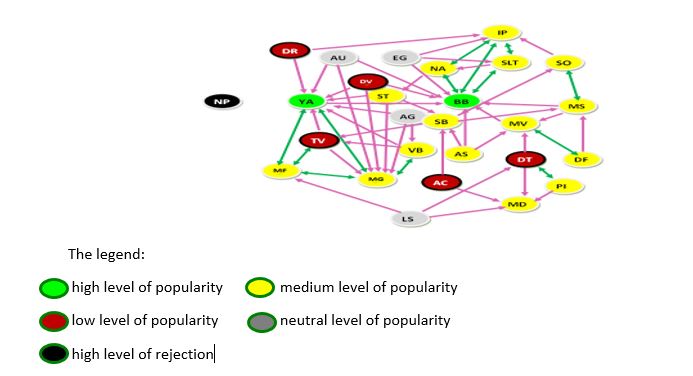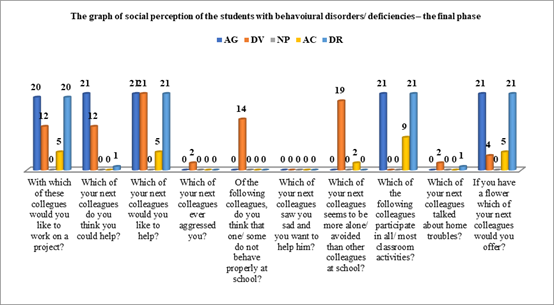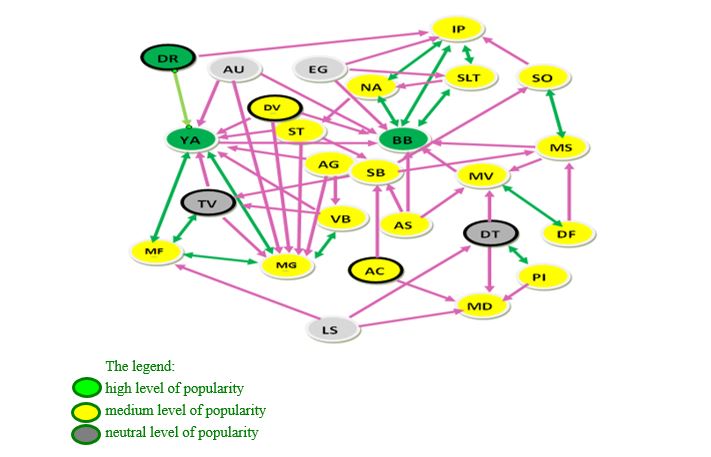Abstract
The paper
Keywords: Personal developmentgroup cohesion"effective homogeneitysocial perceptionpersonal development
Introduction
Education is one of the most effective means of raising living standards, reducing and preventing negative impact phenomena on children and young people, being seen as a key-element that can provide alternatives for solving crisis situations caused by poverty, limited access to information, discrimination, social exclusion etc. Education is an aspect of the socialization process through which people learn specifics behaviours designed to facilitate their active participation in the social life. The school has the as a the main provider of education, but education not only imply schooling, training, transmission and acquisition of knowledge in various fields, is a continuous flow of modelling and transformative influences that will be exercised throughout the individual's life. That is why it is important that these influences to be adequately organized to effectively respond to personal needs, to build, model and transform personalities.
Personal development at the young learner
In Romania, a special importance in the formation and development of the personality of pupils is the responsibility of the discipline Personal Development (PD), school curricula of primary cycle being conceived so as to reach this goal. In the Educational Framework Plan, discipline is part of the curricular area
The complex register of didactic strategies used by the PD discipline, organized in different form, stimulates active participation, and work tasks can be done individually, in pairs or in teams, independently or facilitated by the teacher. As outlined in the curricula for the PD,
Problem Statement
The interdependence between personal development and group cohesion in classroom
The major influence which the group-class exercises has on the formation and on the development of each child's personality is a defining argument in terms of the quality of interpersonal relationships established in this educational space. A good teacher, a good classroom manager, must take into account a number of characteristics that can contribute to the dynamics of the group, such as the degree of
The Handbook of Personal Development for first grade recommends a series of activities aimed to improve the social perception, group cohesion and affective homogenization to the young learners, through exercises of expressing of their opinions and judgments about situations characterised by different feelings (Boca & Barbu, 2015). These activities with a role in increasing of the group cohesion and establishing a positive climate in the classroom are essential, given that the personality of the student emerges and manifests in interdependence with the life of the group to which he belongs, with its norms and values.
Research Questions
The main objectives of our research were:
Theoretical objectives
-
Highlighting the role of education in respect with personal development, socio-emotional and cognitive-behavioural development of young learner.
-
Identification of certain activities performed during Personal Development Class which contributes towards accepting differences between individuals and respecting diversity.
-
Highlighting the level of influence in terms of social perception and group cohesion within a students group.
Applicative objectives
-
The selection for the specific case studies concerning subjects with behavioural disorder and/ or deficiencies such as: aggressiveness, disruptive behaviour during teaching hours, oppositional behaviour (i.e. refusing completing school tasks), excessive introversion, low self-esteem, low school performance, adapting to school environment difficulties, problems regarding group interactions, kleptomania as affective substitute, lack of concentration, obsessive-compulsive habits, language disorders (rhinolalia), dependence on others in meeting basic needs.
-
Predictive evaluation through a whole group survey which aims to establish how the students with behavioural disorders are perceived in order to showcase the importance of affective homogenization of the classroom.
-
Developing and implementing personalized intervention plans (PIP) for each subject of the case study in order to get them having a better adaptation in respect with educational environment.
-
Starting a Continuous Relationship Program to increase the group cohesion and acceptance levels among students and as well to reduce conflicts, improve performance and adapting capabilities.
Hypotheses
In the present research, we targeted the following working-hypothesis:
H1: We work under the assumption that the social perception greatly influences the affective homogeneity and group cohesion of a classroom.
H2: We work under the assumption that a key factor in increasing the acceptance level and bettering the interpersonal relations is the implementation of personalized intervention plans. These plans will be addressed to students with behavioural disorders and /or deficiencies and it will be intertwined with a continuous relationship program with specific personal development activities such as: improving social perception, affective homogeneity, social cohesion.
Purpose of the Study
The general purpose of this research lies in identifying and implementing of modalities of intervention (techniques, methods, and strategies, practices) in order to contribute towards increasing the acceptance level of differences among individuals and bettering the relationships considering group cohesion and, finally, considering school performance levels. In order to conduct this research which lasted for a whole year, we choose 26 first grade students, from "L-R" Secondary School - Bucharest..
Research Methods
To validate the research hypothesis we used several methods as following: 1. case study; 2. records analysis (individual files, observation files analyzed together with the counselling teacher, school marks, medical records etc.); 3. direct/indirect observation; 4. anamnesis; 5. conversation; 6. survey (through the classroom so we can evaluate the social perception of study subjects); 7. analysis of student activities' products; 8. sociometric test. There were three research stages as following:
The
The
During this stage we elaborated our case studies (five different cases, each highlighting a specific characteristic for behavioural disorders/ deficiencies). We worked individually with each child respecting the Personalized Intervention Plan (PIP) which was elaborated considering personality traits and their respective challenges in order to minimize the behavioural disorder’s effects and the its negative impact. The specific objectives aimed the following: to improve the students' learning performances by rising their adapting capabilities to group activities; reducing the perception of differences among students and therefore increasing the level of acceptance; classroom's affective homogenization; mitigating conflicts.
In the
Given the fact that one of the research methods was case study, firstly, we determined the subjects that had traits of personality and behaviour which will be relevant enough in order to validate the established hypothesis. Therefore, for the entire classroom, we selected the students who presented aggressive behaviour, adapting difficulties, problems in relating within the group and excessive introversion. After analysing their personal files, we found that five of these students presented behavioural and socio-affective problems. For the case studies we selected form the whole classroom five representative male students. They will be further noted with the initials: AG, DV, NP, AC and DR. Among these students, one comes from an organised family, the second one from a family with concubine parents, the third from a family which experiences an ongoing divorce, the forth one from a family with 2 years-old divorced parents and the last one has his parents divorced form 3 years already but he is raised exclusively by the mother with no father's input. The average age of these students is 7 years old. To sustain and check the research hypothesis we analysed the entire classroom (not only the chosen five, but as well the rest of 21 students). This approach justifies itself and sustains itself through the emerging need of affective levelling up the classroom in order to mitigate conflicts, increase the acceptance level and ultimately increasing the learning performance.
Findings
In the initial stage we applied a self-made survey so we can see how those five students of case studies are perceived by their colleagues. This survey contained 10 closed-questions where the answer was choosing one of the students' names: AG, DV, NP, AC, DR. The classroom was invited to answer in accordance with their own preferences. The survey was made by the entire classroom, except the five students. Therefore, in the initial stage, from 21 students we obtained the following answers: (Figure

We applied a socio-metric test at the beginning and at the end of the Continuous Relationship Program. The purpose of this test was to establish two things: one is the position of these five students within the inter-personal system (attraction, rejection, indifference, isolation and marginalization) and the second is to establish the group cohesion index. Applying the test at the beginning of the program showed that the group cohesion level is low and the rejection number is higher than the attraction one. The value of the group cohesion index is: Icinitial = 0.67. From the sociometric results it is fairly visible why is necessary to apply the Continuous Relationship Program as one can see that the group needs specialized intervention so it increases its acceptance levels, reducing conflict, which therefore result in improving learning performance. Below, in Figure

At the end of second semester, after completing the cohesion and affective homogenization activities the obtained results were positive. Over this period of time we could observe that the student AG managed to integrate himself in a better way among the group he preferred to get it. The student DR was welcomed in the classroom’s group thanks to the fact that he is a very active child and his sport skills. The student AC, an introvert, managed to integrate in the group which showed high compatibility with him even though the level of appreciation within the group remained at a low. The classroom's attitude towards DV proved to be oscillatory (acceptance and rejection) because of his occasional aggressive behaviours. We need to mention that at the beginning of second semester the student NP (the most rejected by the group, practically, isolated, marginalized) was transferred because of financial-economical reasons. Which is why this student doesn't show any longer in the social perception survey's final results and neither in the sociogram made at the end of the Continuous Relationship Program.
Besides the official personal development activities (group cohesion, affective homogenization), the round-year continuous relationship program included as well extra-curricular activities (i.e. school camps) in which the students had the opportunity to spend time in an informally environment where the rigors of educational institution were less imposing. Such activities aimed to develop the capacity of effective communication and relationship within an informal environment, to develop the ability to work in small teams, sometime in extreme situation, to develop the power of trusting in a group and in oneself.
The answers of the social perception survey applied at the research's end stage were the following: (Figure

As it is shown from the students' answers, one can see an improvement in the subjects' social perception within the group given the absence of the factor "academic environment". It is noted that, during personal development activities, the non-formal environment allowed attitudes and action favouring free speech, easy contact, etc. The existence of such activities which fostered continuous relationship in a less strict way mixed with easy-going activities created the opportunity to establish new kind of interaction among the group members which better consolidated the interpersonal relationships and therefore group cohesion.
At the end of second semester, as a result of group cohesion and affective homogenization activities it is noted that the socio-metric test showed a cohesion index: Icfinal = 1.7. As a conclusion, the group cohesion index increased from 0.67 to 1.7, an important increase reflected as well in the classroom's learning performances (the overall student grades increased in the second semester).
The sociogram of choices at the final stage is as following: (Figure

Regarding the position of the five students of the case studies within the final sociogram, we can observe the following: DR goes from a low popularity level to a high one, DV and AC from a low popularity level to a medium one and AG goes from a neutral popularity level ("ignorance") to a medium one. As stated before, the student NP dropped the program. The group cohesion and affective homogenization activities had positive consequences not only on those who they had a direct intervention but as well on the rest of the classroom, such as TV and DT who from a low popularity level they got to a medium one.
The analysis and interpretation of the results confirms the hypothesis which presumes the interdependence between social perception, affective homogeneity and group cohesion at young school aged. Also, the graph on the level of social perception and the sociogram made in the final stage of the research highlight not only an improvement in the way in which the five students with behavioural disorders/ deficiencies are appreciated by their colleagues, but also a progress regarding their inclusion in the class-group. It is found that their popularity level is higher, following the increase in acceptance of the group. We can affirm that was validated the second hypothesis of the research, which postulated the existence of a positive correlation between the degree of acceptance of interindividual differences and the conduct of some activities with a role in personal development.
Conclusion
The classroom has a major role in the process of socialization. The successful integration of the students within class assure psychological comfort and well-being, lead to high self-esteem, willingness to cooperate and contribute to increasing aspiration, while isolation, social exclusion correlate with anxiety, low self-esteem, hostile feelings towards colleagues, aggressive and oppositional behaviours, negative attitudes towards school, low efficiency.
In this paper we showed that the achievement of the objectives and the validation of our research hypothesis were made largely through specific activities for the Personal Development discipline, included in the curriculum of the primary cycle. Thus, we have highlighted that by introducing activities for the personal development with a role in improving the social perception, affective homogenization and increasing social cohesion, simultaneously with the implementation of personalized intervention plans for students with behavioural disorders and /or deficiencies we have obtained positive results across the classroom. These results are reflected both in the improvement of interpersonal relationships quality as a result of the increase of the degree of acceptance of interindividual differences and high tolerance towards colleagues, as well as in the reduction of the number of conflicts in the classroom. At the same time, overall performance of school class has improved. Also, the positive results have been considerably supported by extracurricular activities that have led to the creation of new relationships between the members of the class and which, by the widening of the group of playing have facilitated and determined the change in the nature and quality of social perception that children have some about each other.
The implementation of the personalized intervention plan adapted to the personality peculiarities and the specific problems of each student of the case studies had a maximum efficiency. The elaboration of the PIP has brought into discussion the necessity to work in multidisciplinary teams. The impact of didactic activities and of the specialized interventions was stronger and more visible for the students with behavioural disorders and / or deficiencies and the results which they obtained at the tests administrated in the final stage of the research demonstrate clearly the remarkable progress they have made. As a consequence of these activities and interventions, at the subjects of case studies it is observed the improvement of self-esteem, self-confidence, positive attitude towards oneself and others (children/ adults), the stimulation of motivation for learning, the direct and open expression of their own opinions, the development of the communication skills, the reduction or the elimination of aggressive and oppositional behaviours, the development of group cooperative behaviours, the assumption of roles and responsibilities in teamwork, increasing of the degree of adaptation to the rules and demands of educational environment.
It can be concluded that the personal development activities have had beneficial consequences on the two dimensions of the classroom: individual (especially in the case of children with problems, whose position within classroom it has shown to have improved) and collective (fact expressed by the group cohesion, higher school performance, the avoidance of labels and stigmatizations, fewer conflicts etc.). Within the discipline Personal Development it is formed and developed skills, attitudes and behaviours that contribute to achieving the well-being of young learners, as well as in their preparation for life and for the future.
References
- Boca, C., & Barbu, D. (2015). Dezvoltare personală. Teorie şi exerciţii. Manual pentru clasa a I-a (Personal Development. Theory and exercises. Handbook for the first class). Bucharest: CD Press.
- Iucu, R. (2006). Managementul clasei de elevi (Classroom Management). Iasi: Ed. Polirom.
- Ministerul Educației Naționale din Romania [MEN]. (2013). Programa şcolară pentru disciplina Dezvoltare Personală. Clasa pregătitoare, clasa I şi clasa a II-a. Anexa nr. 2 la OMEN, Nr. 3418/19.03.2013 [The school curricula for the Personal Development discipline. The preparatory class, the first class and the second class. Annex no. 2 to the Order of the Minister of National Education [OMEN], No. 3418/19.03.2013]. Bucuresti: MEN.
- Morgan, N. S. (2009). Quick, easy and effective behaviour management ideas for the classroom. London and Philadelphia: Jessica Kingsley Publishers.
- Shindler, J. (2010). Transformative classroom management: positive strategies to engage all students and promote a psychology of success. San Francisco: Jossey-Bass A Wiley Imprint.
Copyright information

This work is licensed under a Creative Commons Attribution-NonCommercial-NoDerivatives 4.0 International License.
About this article
Publication Date
15 August 2019
Article Doi
eBook ISBN
978-1-80296-066-2
Publisher
Future Academy
Volume
67
Print ISBN (optional)
-
Edition Number
1st Edition
Pages
1-2235
Subjects
Educational strategies,teacher education, educational policy, organization of education, management of education, teacher training
Cite this article as:
Osiceanu, M., & Danac*, M. (2019). The Importance Of Personal Development And Group Cohesion Within Young Learners Classroom. In E. Soare, & C. Langa (Eds.), Education Facing Contemporary World Issues, vol 67. European Proceedings of Social and Behavioural Sciences (pp. 1080-1089). Future Academy. https://doi.org/10.15405/epsbs.2019.08.03.131
